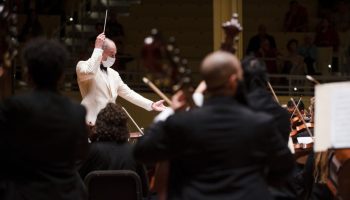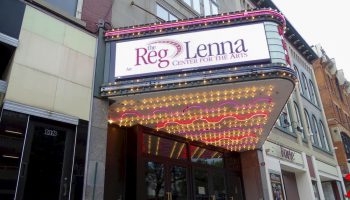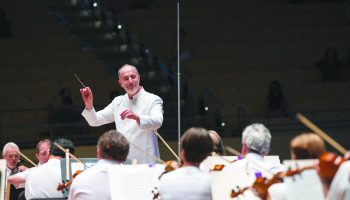Concerto No. 2 in C Minor for Piano and Orchestra, op. 18
Sergei Rachmaninoff
Sergei Vasilyevich Rachmaninoff was born in Oneg, Novgorod on March 20/April 1, 1873, and died in Beverly Hills, California, on March 28, 1943.* Famed as both pianist and composer, Rachmaninoff left Russia after the revolution of 1917, eventually taking up residence in the United States. His Piano Concerto No. 2 was composed in 1900 and 1901 and received the first performance of its last two movements in Moscow on Dec. 2/15, 1900 in Moscow. The first performance of the entire piece took place on Oct. 27/Nov. 9, 1901.* On both occasions, the composer himself was the soloist, with Alexander Siloti conducting the Moscow Philharmonic. The Concerto No. 2 is scored for solo piano, two flutes, two oboes, two clarinets, two bassoons, four horns, two trumpets, three trombones, tuba, timpani, percussion and strings.
*Note: The variation of dates reflect the difference between the Julian and Gregorian calendars.
The Russian-born pianist and composer Rachmaninoff falls into the tradition of the great performer-composers of the Romantic style that began with figures such as Nicco- lò Paganini and Franz Liszt. Like his great predecessors when at their best, Rachmaninoff’s music avoids the self-indulgent kind of virtuosity-for-its-own-sake practiced by less gifted musicians. His music is quite often sentimental, but his melodic gifts were more than sufficient to prevent it from becoming maudlin. Although Rachmaninoff composed a wide variety of music, he is best known for his works for the piano, and his Concerto No. 2 is far and away the most frequently performed of these.
After the failure of his first symphony in St. Petersburg, Rachmaninoff recorded in his Recollections that he lost all hope for any future success. In 1900, he sought psychiatric assistance from Dr. Nikolai Dahl, who, according to the composer, hypnotically persuaded him to continue work on a new piano concerto. Dahl’s positive approach seems to have worked, and he became the recipient of the dedication of the Piano Concerto No. 2. The work received its first performance in 1901 in Moscow, and it was greeted with both critical and popular acclaim.
The work is in three broad movements. The first of these, Allegro moderato, begins quietly with chords solemnly played by the unaccompanied soloist. These grow in intensity, ushering in the lush first theme in the strings. A lyrical second theme emerges from the soloist, followed by a proper development section and a stirring recapitulation in martial style. The Adagio sostenuto is a movement of great beauty and tunefulness whose serenity is only briefly interrupted by an animated middle section that calls for considerable dexterity from the soloist.
The last movement is marked Allegro scherzando, and it plays dramatically between the major and minor mode. As in the first movement, the finale’s second subject is highly lyrical. Following the lead of Tchaikovsky’s Piano Concerto No. 1, which may have served as a model for this piece,Rachmaninoff demarcates the climax of the movement with a tutti statement of the lyrical theme. This produces a triumphant effect, making for a stirring conclusion to a masterpiece of the romantic concerto genre.
Concerto for Orchestra Bela Bartók
One of the seminal figures of 20th-century music, Béla Bartók was born in Nagyszentmiklós, Hungary (now Sânnicolau Mare, Romania) on March 25, 1881, and died in New York City on Sept. 26, 1945. In addition to his brilliant career as a composer, Bartók also was an important ethnomusicologist and pianist. His music is most strongly rooted in Eastern European folk idioms, merged with the modernisms of Debussy, Stravinsky and Schoenberg and the disciplined structure of Johann Sebastian Bach. His Concerto for Orchestra was written in 1944 for the Koussevitzky Music Foundation in memory of Natalie Koussevitzky. Its first performance took place on Dec. 1, 1944, in New York’s Carnegie Hall with the Boston Symphony Orchestra under the direction of Serge Koussevitzky. It is scored for three flutes (piccolo), three oboes (English horn), three clarinets (bass clarinet), three bassoons (contrabassoon), four horns, three trumpets, three trombones, tuba, timpani, percussion, two harps and strings.
The early months of 1943 found Bartók in poor health. Despite this, he managed to deliver three of six scheduled lectures at Harvard University. His hosts insisted, however,that he undergo a thorough physical examination, the results of which revealed lung disease in addition to other problems. The American Society of Composers, Authors and Publishers paid the expenses that enabled Bartók to enjoy a summer retreat at Saranac Lake, New York. But before the composer checked out of his New York City hospital room, the conductor Serge Koussevitzky tendered him an offer of $1,000 from his own foundation for a new work for orchestra that would honor the memory of his wife, who had died during the previous year. Had Bartók, who was ever wary of accepting charity, known that his fellow Hungarian violinist friend, Joseph Szigeti, had been an agent in procuring this commission, he might never have accepted it. As things stood, he was reluctant to accept the commission for fear that his poor health might prevent him from completing the work. Koussevitzky decided to offer Bartók an advance as a demonstration of good faith that the composer’s fears were unfounded. The resulting work, the Concerto for Orchestra, not only was completed, but has gone on to become one of the 20th century’s greatest masterpieces. Its first performance took place on Dec. 1, 1944, in Boston, with Koussevitzky directing the Boston Symphony Orchestra.
The title of this work requires some explanation. Bartók’s own program notes for its premiere indicated that the title “is explained by its tendency to treat the single orchestral instruments in a concertant or soloistic manner.” In other respects, the Concerto for Orchestra is as close as the composer ever came to composing a symphony. The work comprises five movements:
I. Introduzione. A slow theme based on the interval of the perfect fourth — an interval that will play an important role throughout the piece — is presented by the cellos and basses. As the music gains in speed and intensity, the flute, followed by three trumpets, introduces a new figure in the composer’s parlando (speaking) style. The tempo accelerates in dramatic fashion, leading to the main body of the movement, an Allegro vivace in sonata form. Two themes dominate through the remainder of the movement, the first of which has a dance-like character and metrical irregularity. The second idea is stated boldly by the trombone as a type of fanfare. Its potential for thematic manipulation is fully exploited by the entire brass section during the central development section. In an ingenious stroke, the movement ends triumphantly with a final statement of the fanfare theme.
II. Giuoco delle coppie (Game of Pairs). This movement is the first of two scherzos. As a military drum sets the stage, instruments are paraded before us two by two, starting with bassoons, then followed by oboes, clarinets, flutes and muted trumpets. Bartók adds a piquancy to this game by separating each pair of instruments by a set pitch interval. A chorale for the brass, accompanied by the ever-present parade drum, forms the central trio section of the scherzo. The game then resumes with the pairs returning in their original order, this time with the addition of a new counterpoint from the soloists and the rest of the orchestra.
III. Elegia. Those who listen carefully will recognize that Bartók brings back the opening theme from the first movement here. This movement is dominated by a favorite device of the composer, an atmospheric “night” music created by string tremolos and glissandos in the harp and timpani. Other important thematic ideas are entrusted to the oboe and piccolo in this highly evocative movement.
IV. Intermezzo interrotto (Interrupted Interlude). Koussevitzky was an admirer of the Russian composer Dmitri Shostakovich, so he must have been a good sport to have tolerated this movement because it mercilessly satirizes one of Shostakovich’s best-known themes. According to the composer’s son Peter, Bartók heard a live radio broadcast of a performance of Shostakovich’s seventh symphony (“Leningrad”) conducted by Arturo Toscanini. (The Chautauqua Symphony Orchestra will be performing this very work on July 18.) The martial theme from this piece’s first movement struck Bartók as particularly banal. The interlude in the Concerto for Orchestra begins with an agitated oboe solo, followed by a full-blooded romantic melody in the strings, akin to a Spanish serenade. The serenity of this tune is interrupted by the Shostakovich theme, which then becomes the victim of Bartók’s piquant parody, including some “Bronx cheers” from the brass.
V. Finale. A cheeky theme in the horns paves the way for a whirlwind perpetual motion. The composer gives us little chance to catch our breath before he starts to spin a merry fugato based on the horn theme. The music retrenches momentarily, but then accelerates toward the entrance of the trumpet, who offers an appealing and triumphal new theme.
The trumpeter’s colleagues in the brass section join in the exaltation of the moment, presenting this new theme in both its original and an inverted shape. The strings and woodwinds take turns in offering a burlesque of the trumpet theme, but the movement’s recapitulation restores it to its original grandeur.
Musicologist David B. Levy is professor of music at Wake Forest University in Winston-Salem, North Carolina. He has also taught at the Eastman School of Music of the University of Rochester and the University of North Carolina School of the Arts. A Beethoven scholar, he founded the New Beethoven Research Group and has lectured widely throughout the United States and Europe. Levy will deliver a Pre-Concert Lecture on the program for July 12 at 6:45 p.m. in Hurlbut Church Sanctuary.





